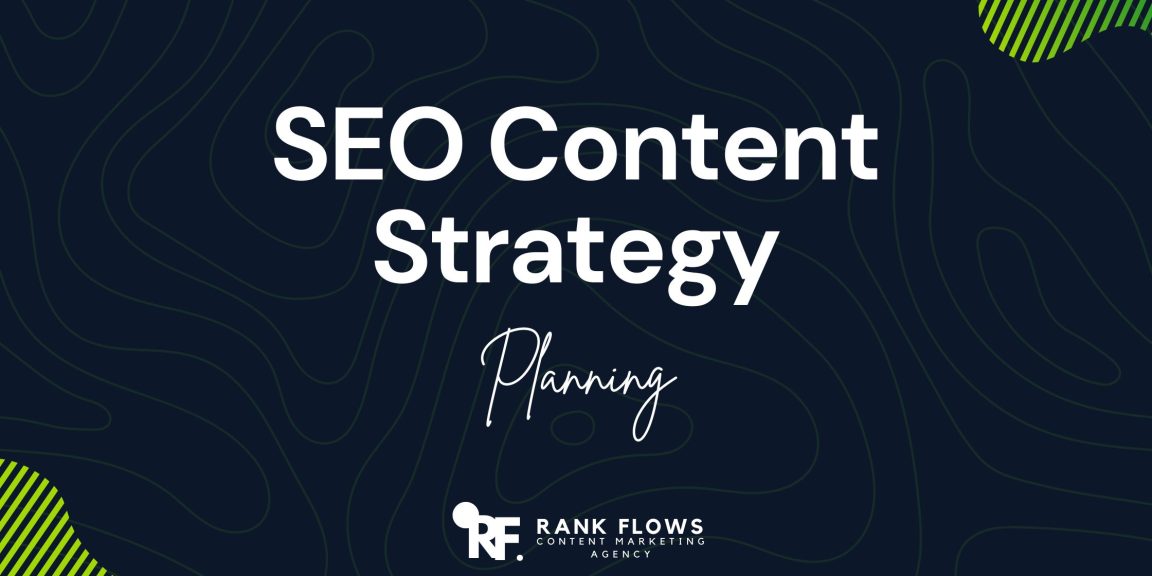Imagine generating $264K in revenue without spending a dime on ads.
That’s exactly what we did for LUXMII, an Australian linen fashion brand. We grew their organic traffic from zero to over 12,000 visits per month, unlocking sustainable, predictable growth and an annual revenue of $264K coming from FREE traffic.

In this post, I’ll take you step-by-step through the exact ecommerce SEO strategy we used to get there.
Grab the Case Study below to see how it works.
Scaling organic traffic isn’t just a nice-to-have; it’s a business necessity.
If you’re relying too heavily on paid traffic, you’re playing with fire. Paid channels (especially Meta) are volatile – one algorithm change and your entire business can take a major hit.
The brand’s dependency on paid ads was eating into profit margins, which is why we shifted our focus to a long-term SEO strategy.
Paid channels, like Facebook Ads, played a key role in LUXMII’s early success. Learn more about the exact Facebook Ads strategy we used to scale revenue quickly before shifting our focus to organic growth.
Organic traffic, on the other hand, compounds over time.
If done properly you can rank for a few hundred keywords in the 1st page and generate lots of organic traffic and money.
In our case with 248 keywords in the first 3 positions we’re pulling in 12,000 visitors every month.
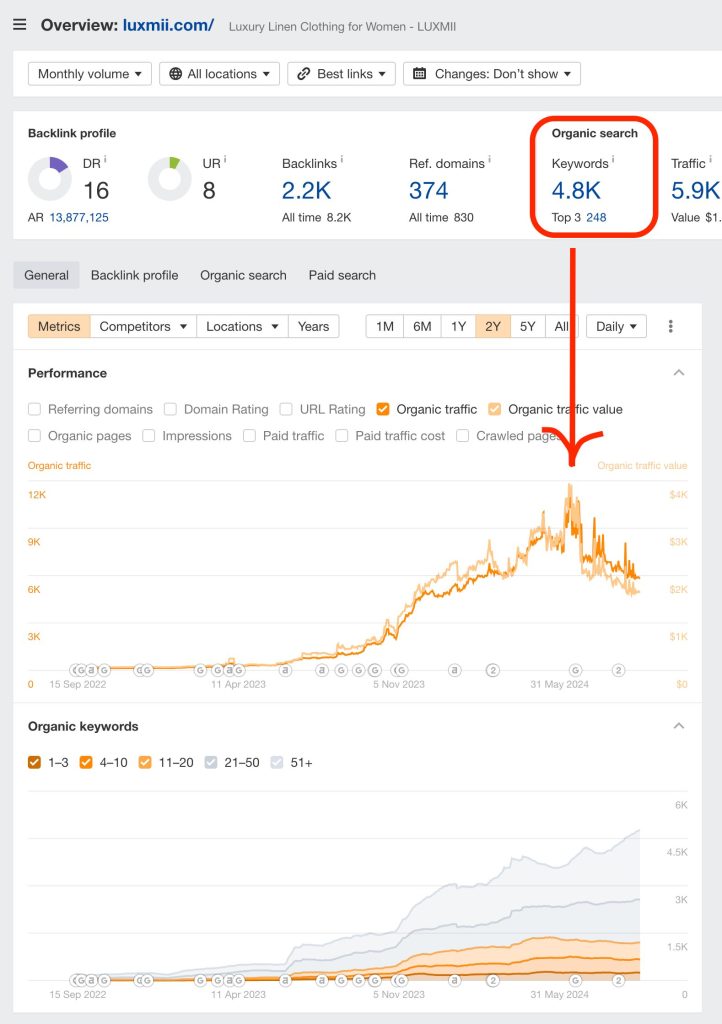
The more you optimize, the more valuable it becomes. In this case study, I’ll walk you through the exact ecommerce SEO strategy we used to transform LUXMII’s traffic – and ultimately turn it into a sustainable business.
A business that has made over $3 million in total revenue, profitably.
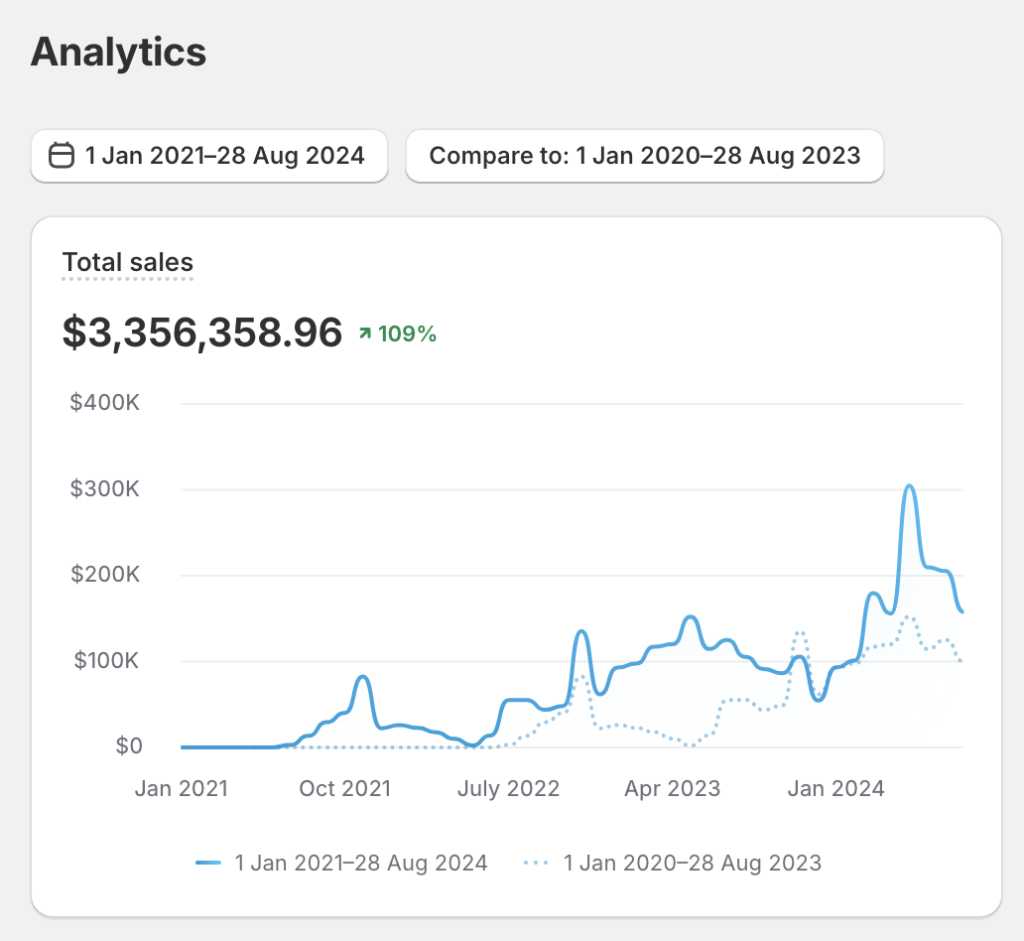
“If you’re looking for a comprehensive blueprint to scale your ecommerce business, explore our in-depth guide on the ecommerce growth strategy. It covers not only SEO, but also effective Facebook Ads, website optimization, and more, all designed to drive sustainable growth.”
Let’s jump in!
The Exponential Traffic Strategy: How to kickoff your Ecommerce SEO Strategy
Nearly anyone who wants to do SEO, wants to skip the foundation stuff and start building backlinks because that’s what they heard is SEO.
Let’s get this straight. In order to do proper SEO you need the correct foundation.
When we began working with LUXMII, there was no SEO groundwork. The site had technical errors, such as broken links, and lacked essential on-page optimization like structured content and keyword targeting.
As a matter of fact here’s exactly how we audited the website and logged the issues:
Choosing the right tools
Audit: In order to crawl the website and find issues
- Screaming Frog
- Ahrefs
- You can also use SEMrush (we didn’t)
Speed Optimization:
- Google Pagespeed Insights to audit our speed
- Squoosh & BulkResizePhotos to optimize images
These tools are used by most seo professionals so you can trust them! Let’s now see how you can use them.
SEO Audit Process
Remove/Redirect 404 links
We found the 404 links and redirected them to the closest and more relevant page. If it was a blog page we redirected the URL to the blog page, if it was a product, we redirected to the parent collection page.
No-Index Duplicate Content
In our experience, every ecommerce website has faced issues with duplicate content. This occurs when 2 or more pages contain identical or very similar content and this can hurt your rankings. Therefore, we set a noindex tag to them – or removed them completely if they were not needed. Duplicate content is typically found on category and product pages.
Fix Missing Canonical Tags
Canonical tags are used to set a page as the original one making it rank easier. Any other page that contains URL parameters or has duplicate content should have a canonical tag pointing to the original page. Some examples:
1. Product page with variants (colors, sizes etc):
- example.com/product/shirt?color=blue
- example.com/product/shirt?color=red
Canonical Tag: Both should have the canonical tag pointing to example.com/product/shirt
2. Category Pages with Pagination
- example.com/category/shoes?page=1
- example.com/category/shoes?page=2
Canonical Tag: Both should have the canonical tag pointing to the main category page, e.g., example.com/category/shoes
3. Filter or Sort Pages
- example.com/category/shoes?sort=price-asc
- example.com/category/shoes?filter=size-10
Canonical Tag: Both should have the canonical tag pointing to the main category page, e.g., example.com/category/shoes
Fill Missing Meta Titles & Descriptions
Although meta descriptions don’t significantly impact search rankings, they can still help boost your website’s click-through rate.
So what we did is we helped craft unique meta titles & descriptions for each page, collection & product, including the main keyword.
The 3+1 Pillars of SEO
Nearly anyone who wants to implement a successful ecommerce SEO strategy knows that there are 3+1 things that need to be done properly:
- Technical: Speed optimization, fixing links and site structure etc.
- On-Page: Keyword research, optimize meta titles & descriptions, headings, images, schema etc.
- Off-Page: Build relevant backlinks to your money pages
- Traffic Multiplier: Blogging + Content Marketing is the key to SEO success (after you’re done with the above)
Let’s explain how we worked on each one and what you should take care of on your ecommerce website.
Technical SEO for Ecommerce Website
Let’s set the foundation first.
The 2 most crucial things we did here were:
- We made sure that the website loads fast. VERY FAST.
- We re-worked the store architecture and navigation.
Speed Optimization
I cannot even imagine a store not loading fast anymore.
In the era of TikTok which has clearly lowered our attention span, people do not want to wait AT ALL. The moment someone enters your website it should load under 1-2”- if not immediately.
Thankfully Shopify helps a lot since they constantly upgrade their servers but this is not enough.
Here are the 5 steps to optimize your ecommerce website speed:
- Use Google Pagespeed Insights & GTMetrix to locate the exact scripts and widgets that use a lot of resources and cause delays.
- If you have the technical knowledge please optimize their size or cut any unwanted scripts. If you don’t hire someone you trust.
- Use apps like Squoosh or BulkPhotoResize to optimize the file size of your images without compromising the quality. You can ask your photographer to export the product images in a web-friendly format. An optimal file size is under 300kb.
- Use external video platforms like Vimeo or Wistia to host your videos. Don’t upload them on Shopify.
- Use apps like SEOAnt or similar to help you further optimize your Shopify store. Be aware to not mess up your theme code. Always backup your files.
Store Architecture
Another very important part of our SEO process is making sure that the store has a clean architecture.
This not only helps customers find what they are looking for easily but also signals Google that the user experience is improved, thus increasing your likelihood of ranking.
There are 2 ways to do your structure: flat and silo.

As LUXMII had a lot of variety regarding its product collections we went for the silo structure.
Why did we do that?
Because by implementing a silo structure:
- We provide an easier website navigation
- We improve the user experience (UX)
- It helps create keyword relevancy & more context (will explain below)
- It facilitates internal linking which lets Google better understand your content
Improving the UX will effortlessly increase the conversion rate, as further analyzed in our “How to build a High-Converting Ecommerce Website Guide“
Here’s how it looks visually:
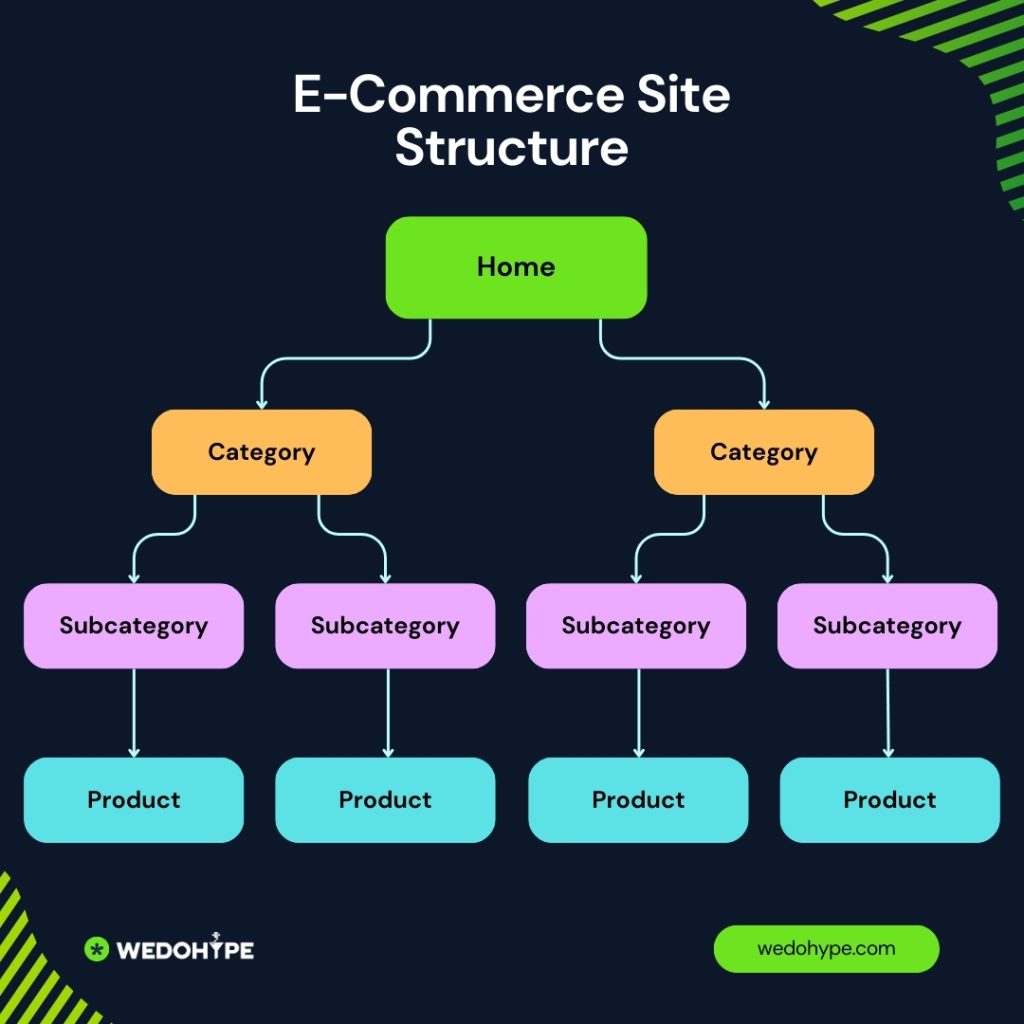
And here’s how it looks on LUXMII’s menu:

Other important technical things you need to keep in mind:
- Have an SSL certificate
- If you have more than one language, make sure to set your hreflang tag
- Submit the sitemap to Google Search Console
- Eliminate/Lower javascript
- 301 redirect older/non-used or not-that-important pages
- Set your structured data
On-Page SEO for Ecommerce Website
As we finished doing the technical stuff, it was time we did some on-page optimizations.
In order to do that you should start with a preliminary Keyword Research.
Keyword Research
This is the process of finding keywords that are relevant to your products & collections and have a high search volume with low competition.
Disclaimer: We’re not allowed to share our keyword strategy in full detail, however I’ll show you the exact process we followed.
Well that’s the ideal plan. Realistically you won’t find high search volume keywords with low competition but shooting for the stars and landing on the moon is not a bad idea.
Here are the 3 things you need to keep in mind while keyword research:
- Go after keywords that may have lower search volume (<200) but have low competition as well.
- Don’t prioritize keywords that have a very high search volume – add them to your plan but don’t go directly after them.
- Focus and categorize based on the intent: you’ll see that not all keywords can be used on your product pages. You may find questions to be used as blog post ideas.
- Be relevant to what your customers are searching for. Don’t go after keywords that have nothing to do with your product just because you found a sexy keyword.
On LUXMII now, after conducting our initial keyword research we found some unexpected insights:
Long-tails brainstormed new Collections
We discovered long-tail keywords that people who are actively seeking to buy use and we created collections based on them. The keyword “linen sleeveless top” for example made us create the relevant collection Linen Sleeveless Top which ranks in the 2nd position. The keyword has a SV of 150.
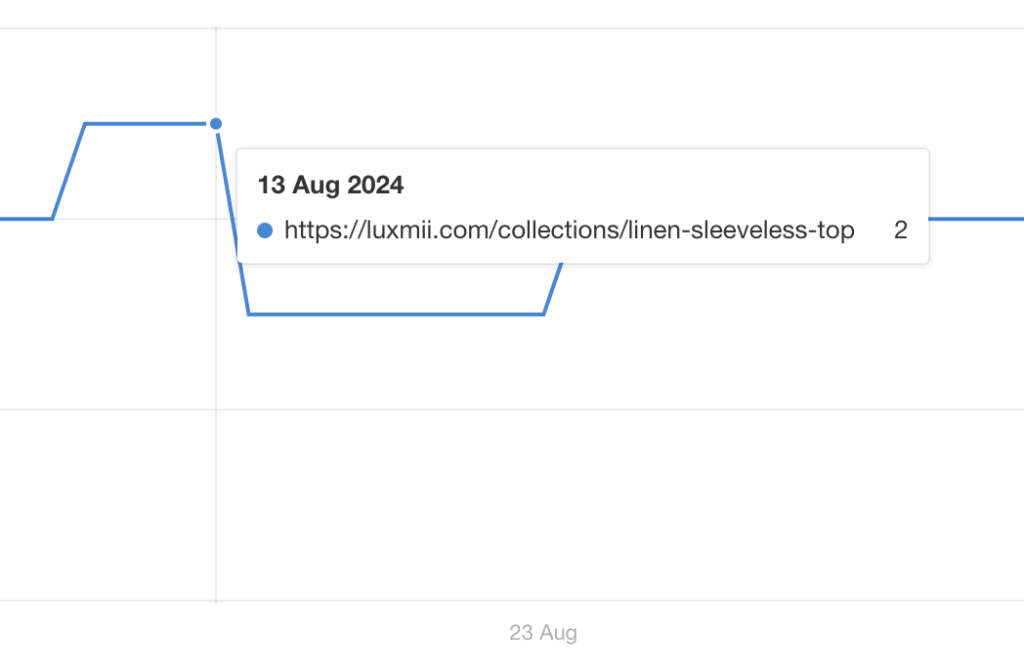
Questions generated our Blog Posts
Answering questions that your audience may have is in my opinion one of the most powerful ways to sell. Not only can you increase your traffic, but you’re also considered a trust-worthy source and an expert in your market. Keywords such as “how to iron linen” with a monthly SV of 800 people led us to create one of LUXMII’s most visited blog posts generating new customers every month – for free.

How to conduct your Keyword Research:
- Make a list of keywords that you believe are relevant to your business
- Use a tool like Ahrefs or SEMrush and plug these keywords in there
- Find the most relevant keywords based on the metrics mentioned above (Search Volume, Competition, Intent & Relevancy)
- Mark them down in a spreadsheet
- Categorize and map each product and collection to a keyword you found
- Keep the educational keywords as ideas for your blog posts
You can follow this guide by Viral-Loops for more details.
Optimizing your Content & Meta Tags (Titles, Descriptions etc.)
First let’s have a look at an example of a “perfectly optimized” page from an ecommerce site.
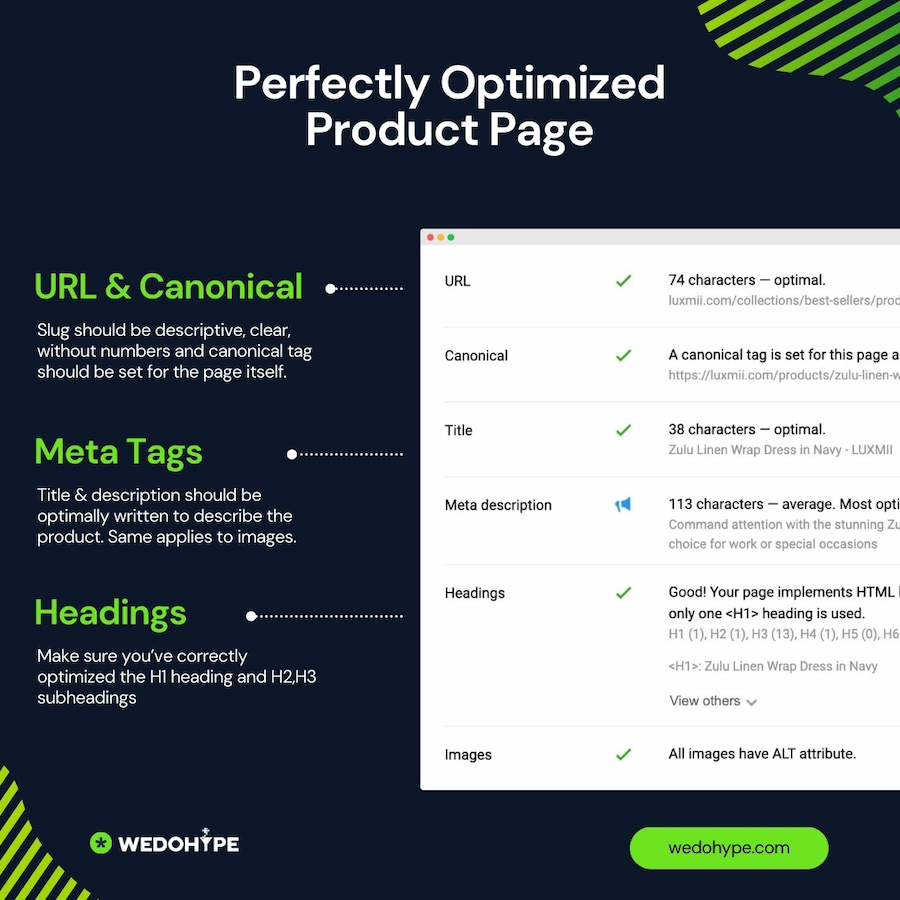
An optimized page should have:
- Title Tag
- Meta Description
- URL Slug
- Heading (H1) and Subheadings (H2, H3…)
- Images
- Breadcrumbs
- Schema Data
- Internal Links
Effective on-page SEO begins with having a well-structured and high-converting website. Learn more about how we rebuilt LUXMII’s high-converting website to drive both organic traffic and sales.
Here’s how to do on-page optimizations to your ecommerce website:
Step 1: Write your Content
Use the keywords you found from Ahrefs and use them across your product & collection page. This includes putting your main keywords and LSI in the title, meta description, URL slug and headings/subheadings.
Extra tip: Include 500+ Words of Content and Use Your Keyword 3-5x on each page.
Step 2: Optimize your Content to Convert
Writing descriptions and titles is not enough. You’re not doing this for Google, you’re doing it for your customers. After all, customers give you money, not Google.
Product pages are the most important part of any ecommerce site, it’s the money-making page. Don’t copy-paste content from other websites. Make sure your content is optimized for conversions by following these tips:
- Show the benefits of the product
- Talk about the problem it solves or for clothing explain the use cases
- Don’t sell the product, sell the outcome
- Try to create emotions
- Explain the technical features and what the package includes
- Include social proof (testimonials and reviews)
- Answer frequently asked questions
Step 3: Optimize the Images
It’s essential to prioritize optimizing your product images if you want them to be found on Google Images, where people search too.
It’s exactly what we did for LUXMII.
How to create and optimize your ecommerce photos:
- Shoot your own in a studio and outside, don’t use others’ images. Be authentic.
- Shoot high quality images. I’m talking about zooming in and seeing the thread.
- Rename the file to match the product. Instead of photo10.jpg use black-linen-top.jpg . Use this app to do it automatically.
- Make sure they’re not over 300kb each.
- Write a unique alt description to describe the product.
If you are running on WooCommerce (or other ecommerce platforms) you could use WPSmush.
Step 4: Setup your Schema Data
Google favors websites that provide rich results to their audience.
Important information like reviews, price and stock availability is crucial for customers.
There are many Shopify apps that set this up automatically.
Step 5: Create internal links
Internal linking is one of the most important things to do when optimizing your website.
We did internal linking by:
- Inserting links to important collections (eg. Linen Dresses) in the description of secondary collections (eg. Black Linen Dresses)
- Implementing upsell widgets in product pages, linking to several other products
- Designing an intuitive navigation menu which lets you find every collection available online
- Linking to money pages (best selling products & collections) from our blog posts
- Interlinking between articles
Off-Page SEO for Ecommerce Website
After completing the above vital stuff it’s time to proceed with the one thing most people care about.
“Ze backlinks”
Since the beginning of LUXMII there were quite a few mentions of the brand on some small websites.
But 2023 Q4 is when we really started to push our link building efforts, as seen below:
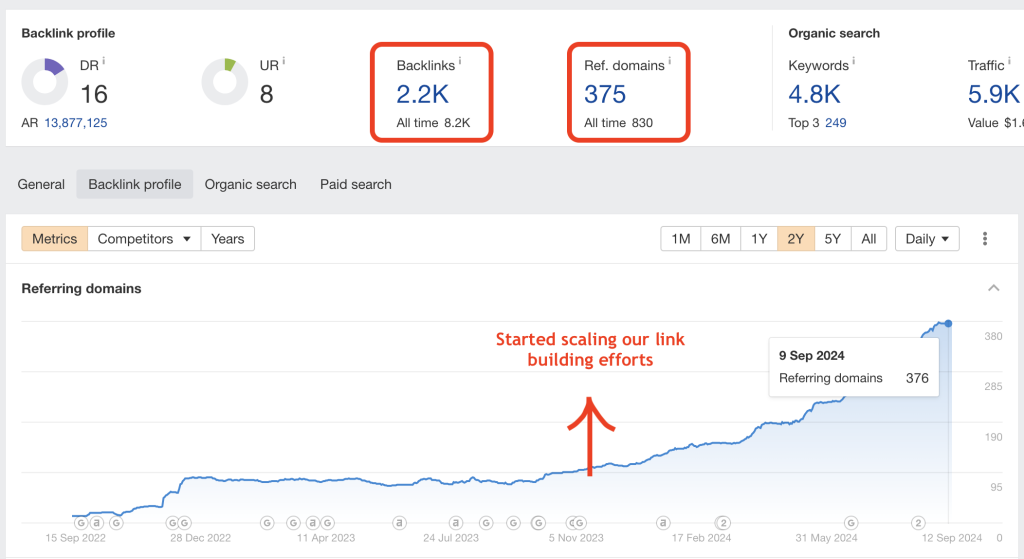
This resulted in 300+ referring domains with over 2k backlinks acquired in less than a year.
Getting backlinks can be quite tricky but if done properly and systematically you can increase your efforts and rankings.
The 5 things we did to implement our link building strategy for LUXMII:
- We started off with link insertions and niche edits.
- We published Press Releases on blogs and media outlets
- We published guest posts on relevant fashion blogs
- We got some natural links from high DR websites like fortune.com
- We got featured into listicles such as “Best Fashion Brands in Australia”
Let’s explain each one and what you can do to replicate the recipe.
- Link Insertions
What’s a link insertion? Well, in a nutshell it’s a link you can place in an existing article/webpage if you think it is relevant or worthy to replace another one.
How do you do it? Go into Ahrefs and use the Content Explorer to search blogs that are relevant to your niche. In our case we searched for fashion blogs and swooped in where we saw an opportunity where “linen clothing” was mentioned in the content. Sorted by Page Traffic and then we started contacting the blog editors by providing our valuable links so they can link to it. For example, having found a post about maternity clothing we placed our maternity clothing collection that could help mothers choose a summer outfit.
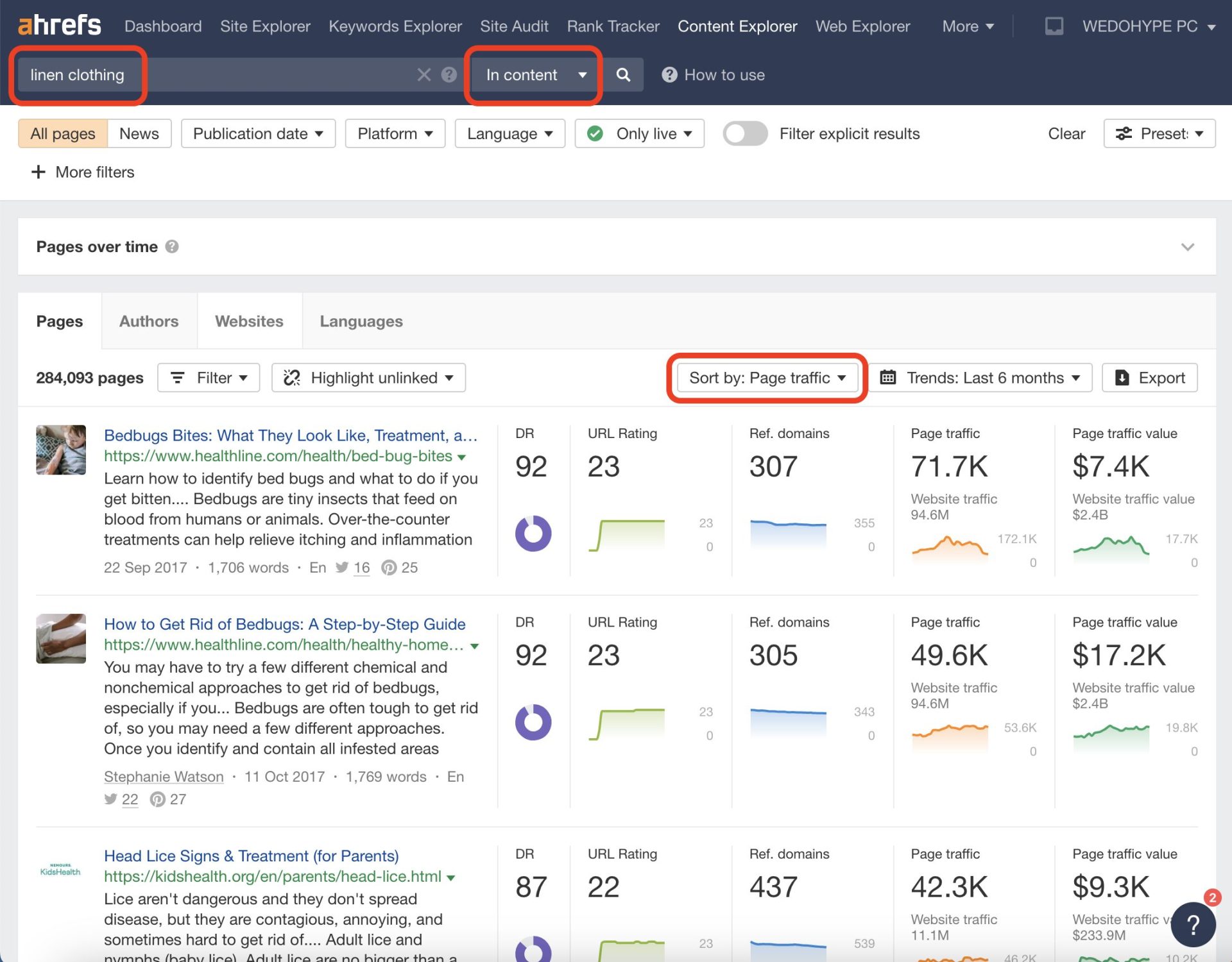
Extra idea: You can use Ahrefs to find broken backlinks of your direct competitors. In our example we used the Broken Backlinks to find the high-DR backlinks that lead to 404 pages of our competitor. What a nice idea to contact the author and replace the link with one of ours.
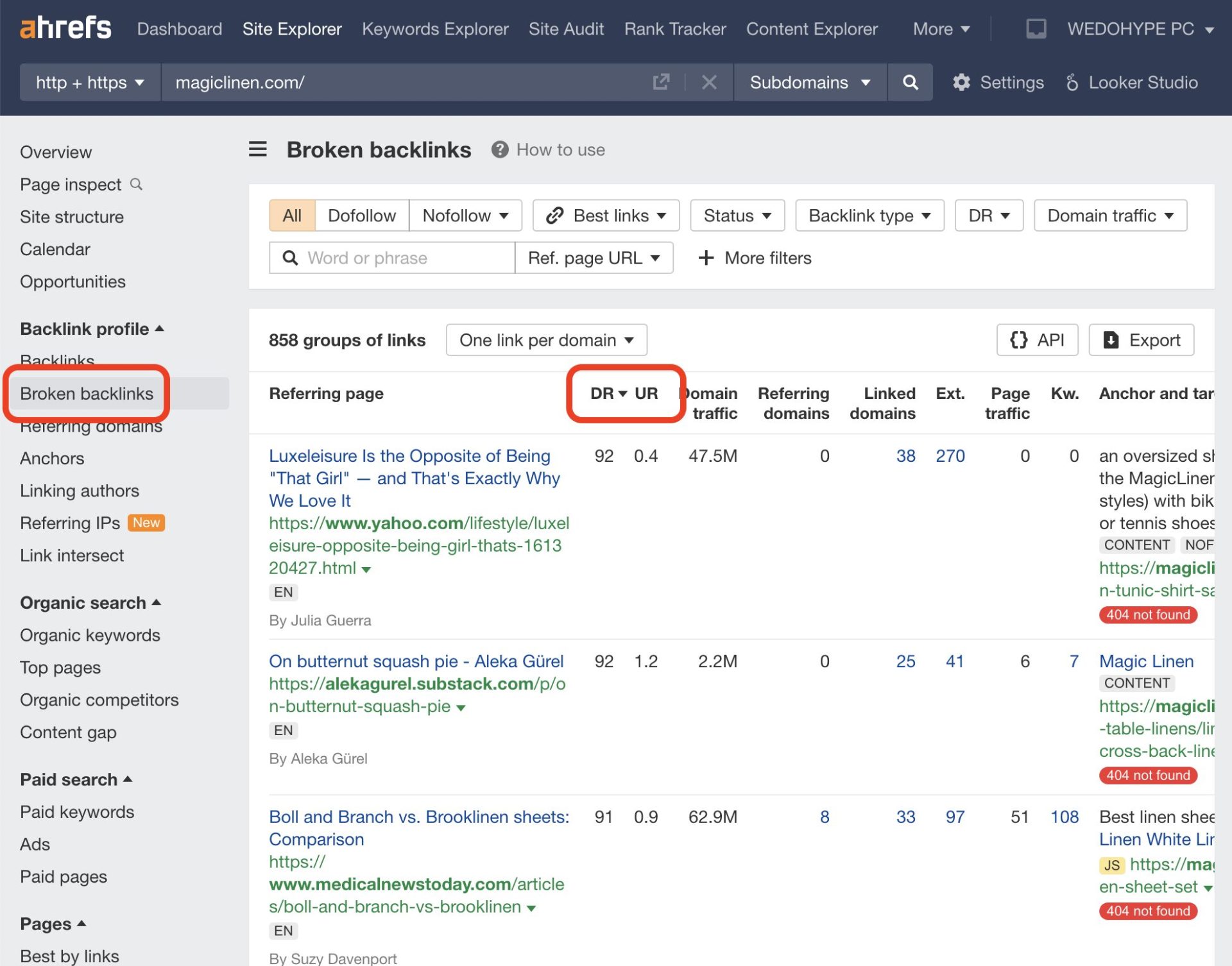
2. Press Releases
This is the easiest way to gain backlinks when you start fresh. Although press releases do not pass high-value “SEO juice” it’s a nice and super easy way to gain both your first backlinks and some press coverage from news websites. In LUXMII’s case we always contact fashion bloggers and media outlets to publish about our brand and mission as well as new product launches.
3. Guest Posts
Yeah, yeah I get it. Nobody wants to do this. But believe me, it’s working. Not only because you can build relevant and high-quality backlinks but you also build healthy relationships with other blogs and you educate your audience with TOFU content.
What we do here is we contact blogs found either via Ahrefs Content Explorer or via Competitors’ Referring Domains and ask them to create high-value content for them in exchange for a dofollow backlink.
This has worked exceptionally well for LUXMII.
4. Natural Links
That’s my favorite.
This comes after you have consistency across all your marketing channels and especially SEO.
Natural links targeting your website and content are built from 3rd party websites or syndications that link to you either because they saw it on a larger website or because they found a useful piece of content that they want to refer to.
This is exactly what happened with LUXMII and Fortune. An editor from Fortune contacted LUXMII because she saw the ads, our content and tried the product and decided it would be nice to write about it. Again we didn’t contact them, they reached out to LUXMII.
After publishing the article a lot of other smaller websites re-published the post giving us a lot more backlinks.
5. Listicles
Finally, we did research on blogs that are creating listing articles.
You must have seen these, being titled “Best X brands for doing Y”.
We contacted the editors asking to be featured on their posts. But note that this was done later than anything else. They won’t accept anyone that has crappy products or is not sharing anything valuable.
Blogging & Content Marketing for Ecommerce Brands
Here’s the fun part.
The part where it’s not just about the technical part but “what your audience needs” part.
And it all comes down to mostly 3 types of content:
- How to use your product (How to iron linen, how to wash linen etc)
- How to wear your clothes (Styling Guides etc.)
- Updates about your business (New product launches, new warehouse, new production process etc.)
The purpose of blogging is not always to rank in Google.
Of course you need to stick to your SEO plan but it’s not all about the keywords here.
It’s about increasing the customer experience by sharing really valuable and educational content that will make people feel emotionally attached to your brand.
But this case study explains the SEO part so let’s dive into it.
Topic Clusters: Increasing your Ranking Chances by 10X
What are Topic Clusters?
It’s the grouping of blog posts around a specific topic and not around a specific keyword.
This enables us to generate traffic using more than 1 keyword around the same topic.
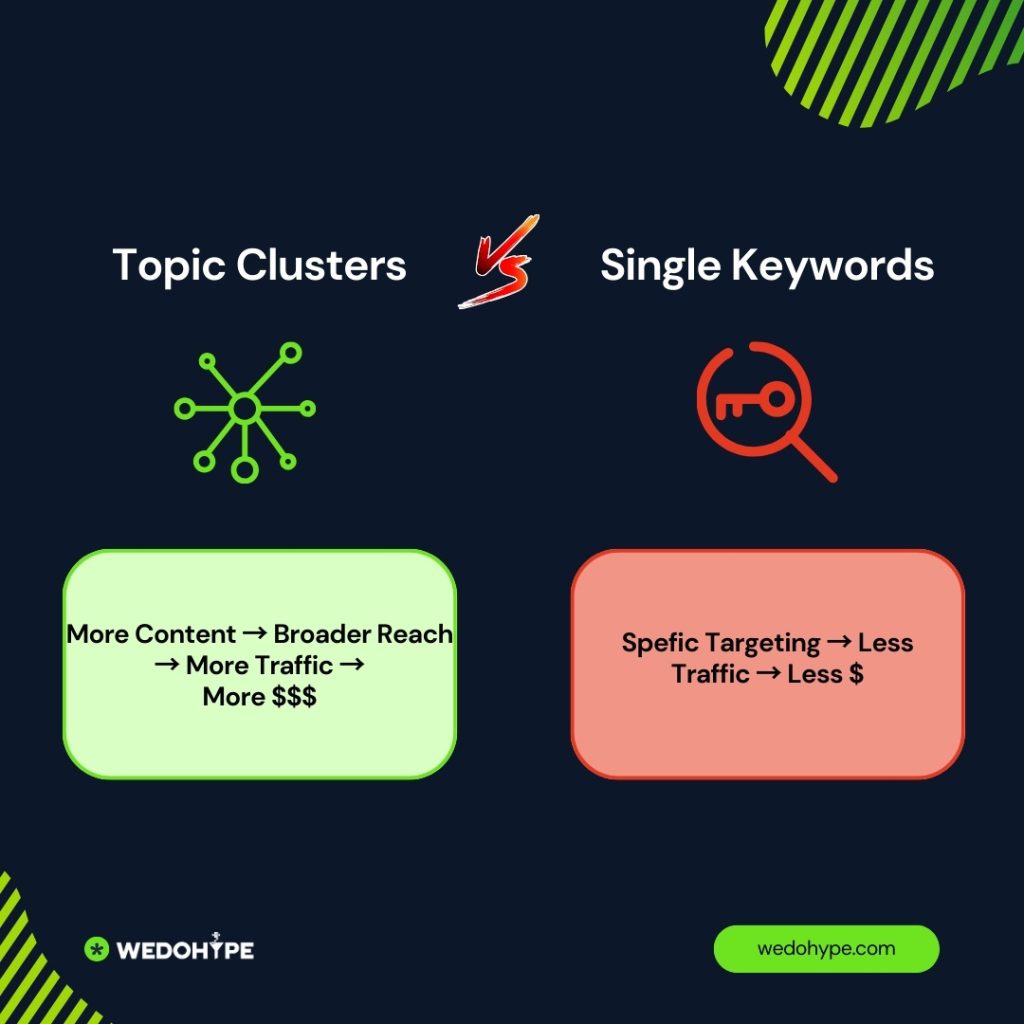
For example, searching for the term “linen shirt” we get the following suggestions:
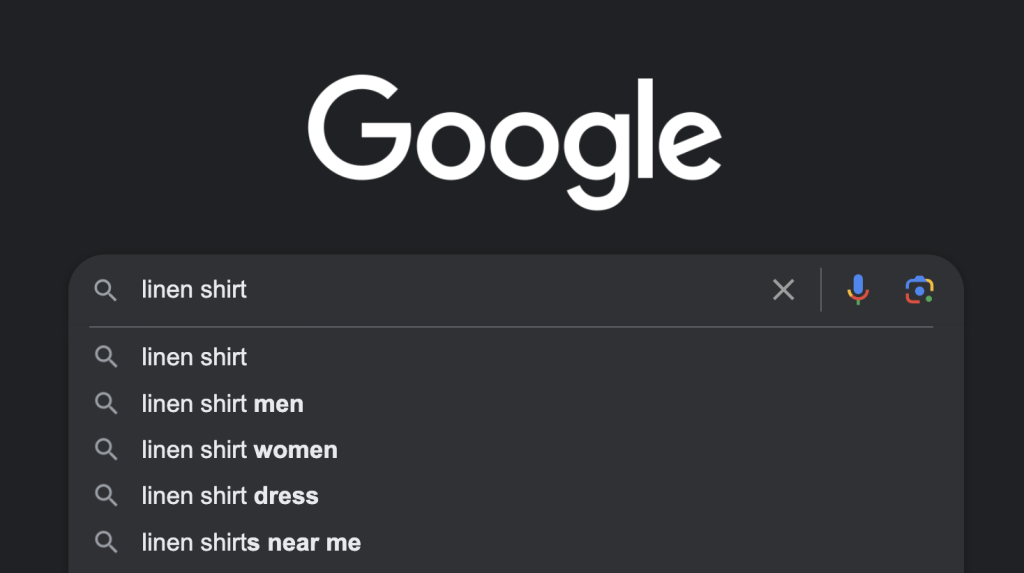
The clustering technique is not new.
From mathematicians to scientists, the term cluster is used to define “grouping”.
The term topic cluster becomes even more understandable in a visual format:

In the diagram above we see that around a main topic “linen” which we consider as a pillar page blog post and related blog posts (sub-topics) which link to the pillar page.
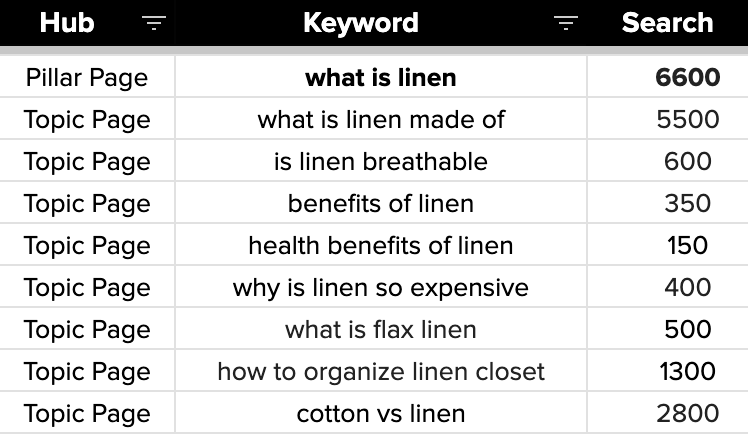
Thus, in this case, we enable Google to understand that we are writing about the topic “linen”.
So by using long-tail keywords to create more blog posts that answer questions, we were able to increase our rankings in Google and thus attract more customers.
How to Create a Topic Cluster
What you need to do is find a topic and create content around it by covering more sub-topics. This is what you should practically do:
Step 1
Use Ahrefs/Semrush to find a keyword with a Search Volume of more than 2.000
Step 2
Make sure that there are plenty of long-tail keywords that could be used as a topic
Step 3
Start writing content using the long-tail keywords and link to each other.
Step 4
Once you’re done creating content, write a bigger one using the main keyword that contains parts of the smaller ones and link to them in order to read more.
After you’re done with the 1st topic cluster you jump onto the next topic cluster to cover even more keywords.
So our process with LUXMII comes down to this:
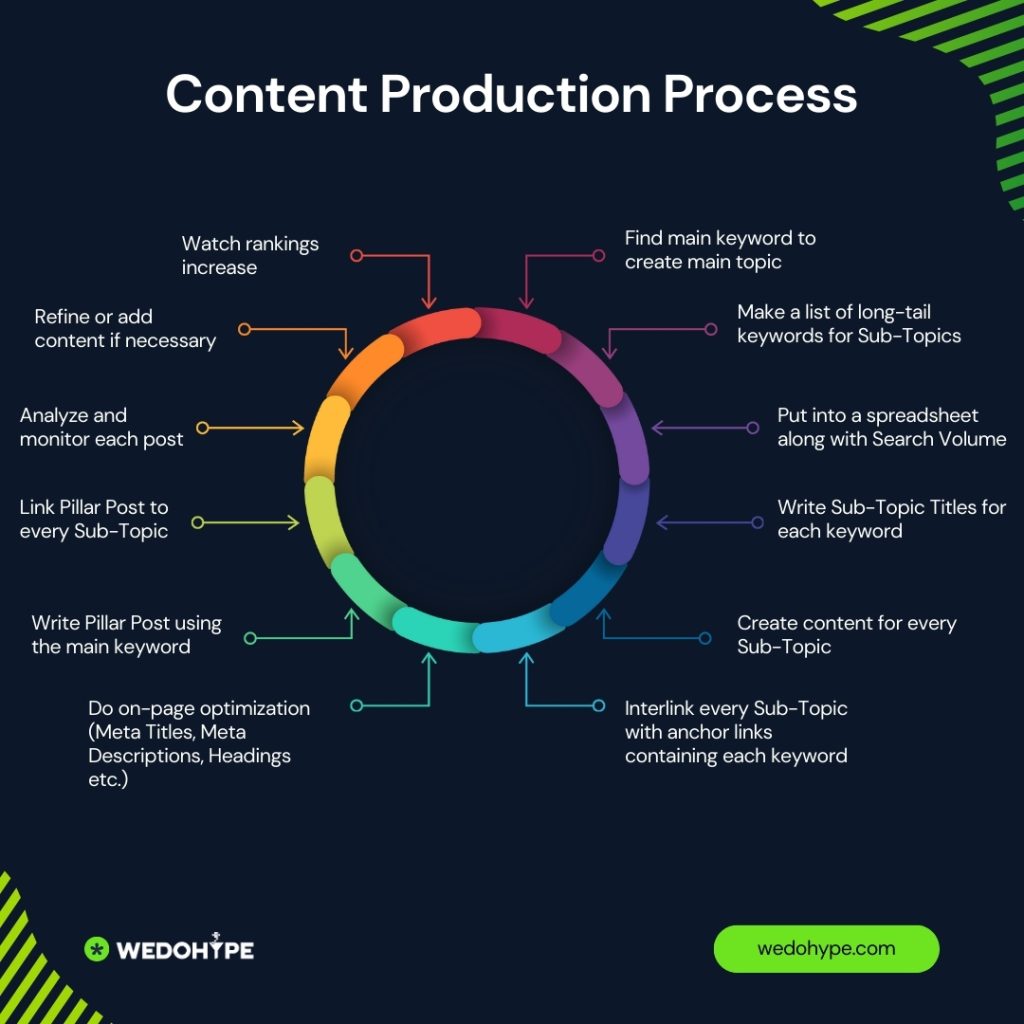
Content Marketing: 20% Production – 80% Sharing
Ok so you wrote the Super-Mega-Ultimate-Blog-Articles of all time.
You hit Publish.
And nothing.
No traffic is there. ZERO.
So is blogging dead?
Yeah, only if you thinkin that hitting the “Publish” button is enough.
Well it’s not.
Producing the blog posts is only 20% of your effort.
The other 80% is promoting the sh*t out of it.
What you need to do is promote your posts across your organic and paid channels. For LUXMII this meant that EVERY blog post is:
- Sent to the 14.000 email subscribers list
- Posted on Instagram Story
- Posted on Facebook page (not that it matters a lot nowadays)
- Published as an ad on Facebook/Instagram
- Sent to outreach partners that want to share to their audiences
This way we’re reaching 3 audiences:
- Core fans: people who belong in the inner circle and are hungry for something new
- Their social circle: people who are friends with the core fans and see these blog posts because someone shared it to them
- Outer Circle: People who have no idea about the brand which get to know the brand by not being forced to buy
Top to bottom they are most likely to convert.
It’s no wonder why LUXMII’s best-performing emails are the ones that promote blog posts.
Your Turn Now
The above ecommerce SEO strategy is exactly what we did to help LUXMII scale to $267 thousand in annual revenue from SEO alone and a total $2 million in total annual revenue.
This means that LUXMII never paid Zuck to generate $267k revenue.
If you hate Zuck too I’ve put together this case study in a PDF format so you can implement it for your own brand.
If you’re just starting out with a small website: Focus on researching low hanging fruits that will let you rank faster for buying intent keywords.
If you’re more established and sales come from paid channels: Focus on perfecting technical + on page SEO and then scale your content marketing efforts to amplify your reach.
Doing one thing is more important than doing everything.
As you drive more traffic to your website, more and more people will start converting, leaving you with a nice and healthy profit margin
This is how you can stop relying entirely on paid channels and instead have organic traffic long term.
Grab the Case Study below to see how it works.
If you’re looking for a comprehensive blueprint to scale your ecommerce business, explore our in-depth guide on the ecommerce growth strategy. It covers not only SEO, but also effective Facebook Ads, website optimization, and more, all designed to drive sustainable growth.
Don’t have time to execute your ecommerce SEO strategy? Book a call and I can help you scale your traffic like LUXMII.
This case study was originally posted on the sister company here.

